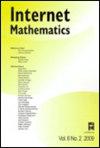A Fast Algorithm to Find All High-Degree Vertices in Graphs with a Power-Law Degree Sequence
Q3 Mathematics
引用次数: 10
Abstract
Abstract We develop a fast method for finding all high-degree vertices of a connected graph with a power-law degree sequence. The method uses a biased random walk, where the bias is a function of the power law c of the degree sequence. Let G(t) be a t-vertex graph, with degree sequence power law c ≥ 3 generated by a generalized preferential attachment process that adds m edges at each step. Let Sa be the set of all vertices of degree at least ta in G(t). We analyze a biased random walk that makes transitions along undirected edges {x, y} with probabilities proportional to (d(x)d(y))b, where d(x) is the degree of vertex x and b > 0 is a constant parameter. With parameter b = (c − 1)(c − 2)/(2c − 3), the random walk discovers the set Sa completely in steps with high probability. The error parameter ε depends on c, a, and m. The cover time of the entire graph G(t) by the biased walk is . Thus the expected time to discover all vertices by the biased walk is not much higher than the Θ(tlog t) cover time of a simple random walk. The standard preferential attachment process generates graphs with power law c = 3. The search parameter b = 2/3 is appropriate for such graphs. We conduct experimental tests on a preferential attachment graph and on a sample of the underlying graph of the World Wide Web with power law c ≈ 3 that support the claimed property.幂律度序列图中所有高次顶点的快速查找算法
提出了一种快速求幂律度序列连通图的所有高次顶点的方法。该方法使用有偏随机漫步,其中偏差是度序列幂律c的函数。设G(t)为一个t顶点图,其度序列幂律c≥3是由每步增加m条边的广义优先附加过程生成的。设Sa为G(t)中度数至少为1的所有顶点的集合。我们分析了一个有偏随机漫步,它沿着无向边{x, y}进行过渡,其概率与(d(x)d(y))b成正比,其中d(x)是顶点x的度,b > 0是一个常数参数。当参数b = (c−1)(c−2)/(2c−3)时,随机行走完全分步高概率地发现集合Sa。误差参数ε取决于c, a和m。整个图G(t)的覆盖时间为。因此,通过有偏行走发现所有顶点的期望时间并不比简单随机行走的Θ(tlog t)覆盖时间高多少。标准的优先依恋过程生成的图具有幂律c = 3。对于这样的图,搜索参数b = 2/3是合适的。我们对一个优先依恋图和一个支持所声称属性的幂律c≈3的万维网底层图样本进行了实验测试。
本文章由计算机程序翻译,如有差异,请以英文原文为准。
求助全文
约1分钟内获得全文
求助全文

 求助内容:
求助内容: 应助结果提醒方式:
应助结果提醒方式:


